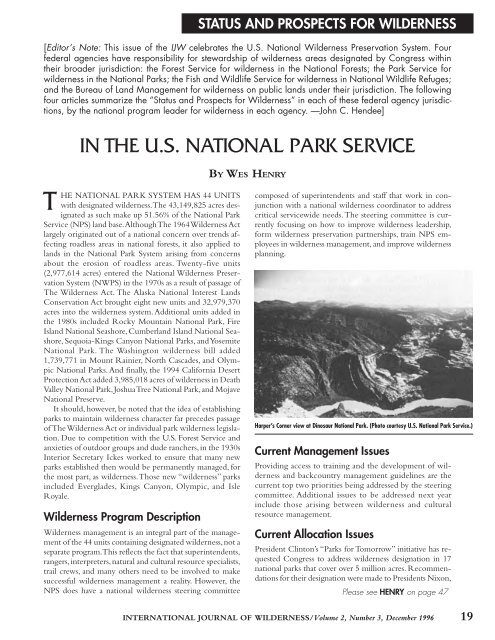P3-Vol 2.No3 Dec 96 - International Journal of Wilderness
P3-Vol 2.No3 Dec 96 - International Journal of Wilderness
P3-Vol 2.No3 Dec 96 - International Journal of Wilderness
You also want an ePaper? Increase the reach of your titles
YUMPU automatically turns print PDFs into web optimized ePapers that Google loves.
[Editor’s Note: This issue <strong>of</strong> the IJW celebrates the U.S. National <strong>Wilderness</strong> Preservation System. Four<br />
federal agencies have responsibility for stewardship <strong>of</strong> wilderness areas designated by Congress within<br />
their broader jurisdiction: the Forest Service for wilderness in the National Forests; the Park Service for<br />
wilderness in the National Parks; the Fish and Wildlife Service for wilderness in National Wildlife Refuges;<br />
and the Bureau <strong>of</strong> Land Management for wilderness on public lands under their jurisdiction. The following<br />
four articles summarize the “Status and Prospects for <strong>Wilderness</strong>” in each <strong>of</strong> these federal agency jurisdictions,<br />
by the national program leader for wilderness in each agency. —John C. Hendee]<br />
T<br />
IN THE U.S. NATIONAL PARK SERVICE<br />
HE NATIONAL PARK SYSTEM HAS 44 UNITS<br />
with designated wilderness. The 43,149,825 acres des-<br />
ignated as such make up 51.56% <strong>of</strong> the National Park<br />
Service (NPS) land base. Although The 1<strong>96</strong>4 <strong>Wilderness</strong> Act<br />
largely originated out <strong>of</strong> a national concern over trends affecting<br />
roadless areas in national forests, it also applied to<br />
lands in the National Park System arising from concerns<br />
about the erosion <strong>of</strong> roadless areas. Twenty-five units<br />
(2,977,614 acres) entered the National <strong>Wilderness</strong> Preservation<br />
System (NWPS) in the 1970s as a result <strong>of</strong> passage <strong>of</strong><br />
The <strong>Wilderness</strong> Act. The Alaska National Interest Lands<br />
Conservation Act brought eight new units and 32,979,370<br />
acres into the wilderness system. Additional units added in<br />
the 1980s included Rocky Mountain National Park, Fire<br />
Island National Seashore, Cumberland Island National Seashore,<br />
Sequoia-Kings Canyon National Parks, and Yosemite<br />
National Park. The Washington wilderness bill added<br />
1,739,771 in Mount Rainier, North Cascades, and Olympic<br />
National Parks. And finally, the 1994 California Desert<br />
Protection Act added 3,985,018 acres <strong>of</strong> wilderness in Death<br />
Valley National Park, Joshua Tree National Park, and Mojave<br />
National Preserve.<br />
It should, however, be noted that the idea <strong>of</strong> establishing<br />
parks to maintain wilderness character far precedes passage<br />
<strong>of</strong> The <strong>Wilderness</strong> Act or individual park wilderness legislation.<br />
Due to competition with the U.S. Forest Service and<br />
anxieties <strong>of</strong> outdoor groups and dude ranchers, in the 1930s<br />
Interior Secretary Ickes worked to ensure that many new<br />
parks established then would be permanently managed, for<br />
the most part, as wilderness. Those new “wilderness” parks<br />
included Everglades, Kings Canyon, Olympic, and Isle<br />
Royale.<br />
<strong>Wilderness</strong> Program Description<br />
<strong>Wilderness</strong> management is an integral part <strong>of</strong> the management<br />
<strong>of</strong> the 44 units containing designated wilderness, not a<br />
separate program. This reflects the fact that superintendents,<br />
rangers, interpreters, natural and cultural resource specialists,<br />
trail crews, and many others need to be involved to make<br />
successful wilderness management a reality. However, the<br />
NPS does have a national wilderness steering committee<br />
STATUS AND PROSPECTS FOR WILDERNESS<br />
BY WES HENRY<br />
composed <strong>of</strong> superintendents and staff that work in conjunction<br />
with a national wilderness coordinator to address<br />
critical servicewide needs. The steering committee is currently<br />
focusing on how to improve wilderness leadership,<br />
form wilderness preservation partnerships, train NPS employees<br />
in wilderness management, and improve wilderness<br />
planning.<br />
Harper’s Corner view at Dinosaur National Park. (Photo courtesy U.S. National Park Service.)<br />
Current Management Issues<br />
Providing access to training and the development <strong>of</strong> wilderness<br />
and backcountry management guidelines are the<br />
current top two priorities being addressed by the steering<br />
committee. Additional issues to be addressed next year<br />
include those arising between wilderness and cultural<br />
resource management.<br />
Current Allocation Issues<br />
President Clinton’s “Parks for Tomorrow” initiative has requested<br />
Congress to address wilderness designation in 17<br />
national parks that cover over 5 million acres. Recommendations<br />
for their designation were made to Presidents Nixon,<br />
Please see HENRY on page 47<br />
INTERNATIONAL JOURNAL OF WILDERNESS/<strong>Vol</strong>ume 2, Number 3, <strong>Dec</strong>ember 19<strong>96</strong> 19










